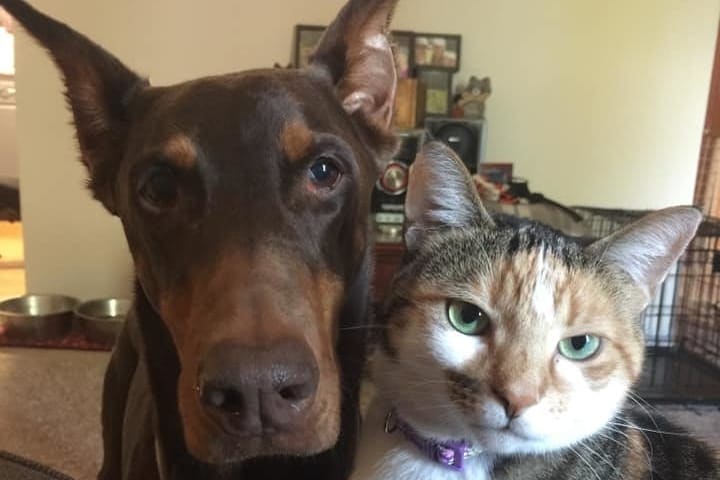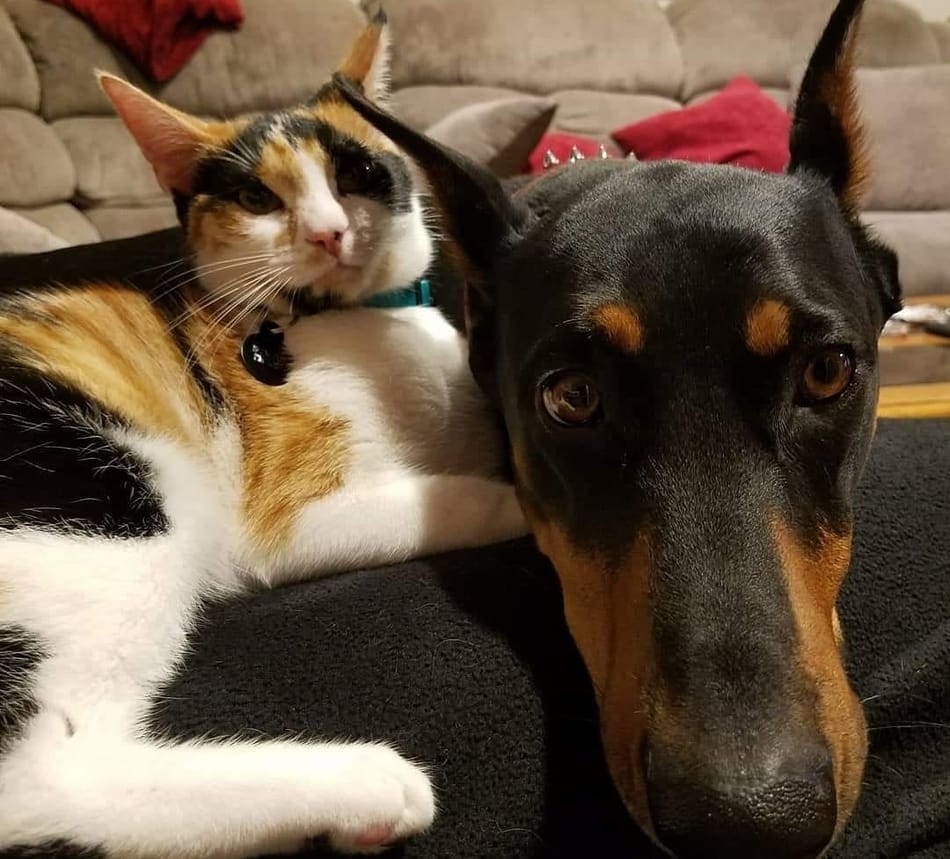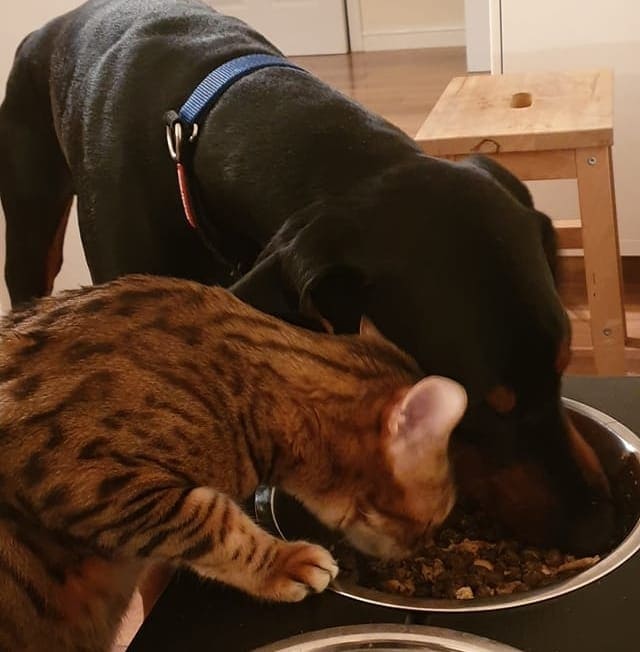
Although I’ve debunked this notion many times on this site, it’s no secret that the Doberman breed has a reputation for being protective and aggressive. So naturally many potential owners are worried about how these dogs might get along with their other pets. Dobermans are natural predators of small animals—so what does this mean for their interactions with small furry animals like cats? Can you successfully acclimate your Doberman to your favorite house cat so the two can live in peace?
Can Dobermans get along with cats? A properly socialized Doberman is very capable of getting along with a house cat. An adult Doberman, who has not been properly socialized previously, can still learn to get along with small cats with careful, supervised interactions of gradually increasing durations.
While every Doberman is an individual, and there doesn’t seem to be a general rule when it comes to how well they get along with house cats, there are some things that you can do to help things go smoothly. The ability of a certain dog to get along with a small animal like a cat depends largely on their trainability. Lucky for you, Dobermans are highly trainable and intelligent dogs. Take some basic precautions, however, since it’s true that Dobermans are instinctually natural predators of small animals.
Dobermans and Cats in the Same Household
It’s important to note that Dobermans all have their own personalities and some may be more predatory in nature than others. While I believe that all Dobermans can get along just fine with a housecat (with enough careful training), some will certainly bond with a cat in the same house quicker and easier than others.
If you haven’t gotten your puppy yet, it’s a great idea to quickly read over my article where I discuss how to use personality testing on Doberman puppies to make sure you get a dog with a natural temperament that will help them naturally get along with other animals.
To get a better idea of what is normal for the Doberman breed, you need to go straight to those owners who have both a Doberman and a cat living in the same house. For that, iHeartDogs.com conducted a survey of a large pool of Doberman owners with that exact situation. Below are the results of that poll.

Polling Results: How well does your Doberman get along with your cat?
- They get along “very well”: 28%
- They get along “ok”: 47%
- They don’t get along: 25%
Based on this information provided by Doberman owners, you likely have about a 75% chance of having your Doberman and your cat get along “ok”, or better. You only have about a 25% chance of the two of them not getting along.
I would go further and say that the 25% number could be even smaller if more work and careful attention were put into introducing the dog with the cat. I believe those reading this article, who cares enough to do research about these two animals living together, will also care enough to put the work required in and will see much higher success rates than this.
The dangers with these two animals living together come when you have a Doberman who is slightly more on the predatory side, and a younger cat who is a little more energetic than most. A fast-moving furry animal is a recipe to trigger the Doberman’s natural drive to hunt. In other words, if you have an older house cat that’s fairly calm, you are much more likely to see them get along with your Doberman without any issues.
In most instances, you’re more likely to see a Doberman lounging around and relaxing with a cat, or playing some playful games together, than you are to see a Doberman attempting to hunt a cat in a truly aggressive manner.
Exposing Your Doberman to Cats as a Puppy
The first year in any dog’s life, regardless of breed, is the most essential, and this is certainly the case for Dobermans. This is the time frame when habits, anxieties, and behaviors are formed or reinforced. If your Dobie isn’t exposed to any animals in his first year of life, he’s probably going to react badly when he encounters them later on.
If your Doberman is in his first year of life as you’re reading this, congrats! You’re in the best possible position to ensure that you can end up with an adult Dobie who is very gentle with all animals, including cats. The key here is careful socialization with as many new experiences (and animals) as possible. Never miss an opportunity to bring your dog to gatherings where new people, kids, other dogs, or other animals might be present.
Key Points for Exposing a Young Doberman to a Cat
- Calm and Relaxed: Make sure the meeting time stays calm and relaxed. Start with the cat a short distance away from your puppy, and try to avoid too much attention being placed on the cat. Teach your dog it’s “no big deal” when the cat is around. Keep yourself calm and relaxed so your dog will be more likely to stay that way. Don’t let things get too playful initially (you can relax on this later).
- Areas of Retreat: Ensure that both the cat and the dog have ways to walk away from the encounter if it gets to be too much for them. If either one gets overwhelmed and is unable to escape, it will likely do permanent damage to the relationship between the two animals.
- Supervised at all Times (initially): It’s very important that at least the first handful of times your Doberman and your dog meet, it’s very closely supervised. A bad experience early on can cause lifelong disdain between the two. Keep your dog on a leash so you can pull him away if things get too rough.
- Positive Experience: Do anything and everything you can to keep this experience a positive one. You want your dog to grow up having positive feelings when he sees your cat. Treats and extra praise work wonders.
As a puppy, your Doberman is far more likely to express playful curiosity during their first meetings with your cat than they are any type of aggression. Playful curiosity is a much easier starting point for acclimation to a cat and that’s why it’s so important for them to be exposed at a young age.
Exposing an Adult Doberman to Cats
Introducing an adult Doberman to a cat for the first time can be a bit more challenging. This is because your dog has likely already formed opinions and feelings surrounding small furry animals. If these feelings are not conducive to a good relationship between him and the cat, there could be a lot of problems getting them to enjoy each other’s company.
How cautiously and slowly you proceed with introducing your adult Doberman to your cat should be based on how close you feel your dog is to accepting the cat and her company. If your dog absolutely hates cats and you’re trying to effect a significant behavior change, you should proceed with the most caution possible (and as slowly as possible) as this will be the most difficult to address.
If your adult Dobie just hasn’t seen a cat up close before but is gentle with other small furry animals, then you’re likely to see success by proceeding through some of these steps at a little faster pace. You may even be able to skip a few of these steps. For the sake of this article, I will outline all the steps below for the most difficult of cases (adjust your course of action accordingly).
- Expose them to each other’s scent. Exposing your Doberman and cat to each other via scent only is far less intense than an in-person meeting. So start by having your dog and cat in separate rooms from each other where they can smell each other under the door, for example. Do this for a few days. Then put one of your old t-shirts in the bed with your cat for a night. The next day, put it in the bed with your Doberman. When he sniffs at the shirt, praise him, give him a treat, and make it an overall positive experience.
- Alternate their rooms. After getting them somewhat used to each other’s scent, try switching rooms with the two animals for the next day or two. That way each animal is now further exposed to the other’s scent. Remember, keep it a positive experience. Make switching rooms fun with games, treats, and praise!
- Introduce them through a barrier. The next step is to finally let them see each other, but make sure there is some sort of barrier between them. Having your dog in a room with a see-through child’s gate or dog gate keeping them contained inside, and your cat outside, is a great first step. They’ll be able to see each other and sniff each other. Allow your Doberman to see the cat, but don’t put too much emphasis on the cat’s presence. You want the cat’s presence to not be a big deal in the end, so don’t make it one now. For example, play ball with your dog inside the room while your cat walks past the outside of the room.
- Introduce them in person with no barrier. The final step is to introduce them in a room without a barrier. If everything has gone smoothly to this point, this step should be pretty uneventful. Keep your dog on a leash so you can pull him away if there are any problems, and make sure the cat always has a means of escape from the situation. Start with the cat at a distance and then take a break. With each future session, allow the cat to get closer until they have a full face-to-face greeting. Remember to give your dog lots of praise. Be cautious that the dog doesn’t accidentally hurt the cat by batting at him with his paws (which is common for Dobermans to do). If you’re really worried, you could get your dog a muzzle to wear for their first few meetings.
Most Doberman’s won’t need to go through each step listed above in such detail and careful progression. The above steps are great if you have a Doberman who is unusually aggressive towards small animals, but most will be able to breeze through these steps in a day or two. Don’t be afraid to modify the steps above to best fit your situation.
If your Doberman is a rescue dog or one whose history is unclear to you, it’s best to assume the worst and take each of these steps carefully and slowly. A Doberman whose background you don’t know may act fine with a cat at one minute, but hunt them the next. So proceed with caution if that’s your situation.
For more information about aggression in Dobermans, see my article Are Dobermans Mean, Dangerous, or Overly Aggressive.
Signs of Aggression Towards the Cat
You’ll want to know what signs of aggression in your dog look like so that if you spot those while going through the process of introducing him to your cat, you can slow everything down, back up a step or two, or stop it completely.
Signs of Aggression:
- Stiffened body posture.
- Raised hair on the back.
- Growling/snarling.
- Erect ears and/or tail.
- Showing of teeth.
If you spot any signs of aggression such as these, it means you need to slow things down and do an even more careful introduction. Maybe even go back a step or two. For example, if you saw aggression on their first face to face meeting, it might be best to go back to introductions via scent only for a while before trying again
Don’t be afraid to correct your dog, but don’t give harsh corrections (think of giving more guidance than a correction) and don’t forget lots of positive reinforcement when your dog smells the cat or is gentle with the cat. If you don’t make your Dobie’s experience with your cat a positive one for him, you’ll have a very difficult time succeeding.

Act Calmly and Keep Your Cool
Acting calmly and keeping cool are among the most important things you can do to eliminate or discourage aggression between your Doberman and other pets. Most animals can generally sense the fear and anxiety of humans, so if you feel worried or stressed as your Doberman is interacting with other pets, he will pick up on it – and probably respond in a manner opposite of what you’d like.
While it can be difficult not to feel a bit stressed during the first few interactions, control your own anxiety as best you can to put your pup at ease. The Doberman breed, in particular, is known for fierce loyalty and protection of their owners, so sensing fear in you will only kick in those protective instincts even more. Reinforce to your dog that there is nothing to fear by showing him that you do not feel threatened by the animal you’re introducing him to.
“When your Doberman is able to remain positive or neutral in the presence of the cat, always reward him with treats, a new toy, or praise. Repetition and consistency are key.”
– John Walter
DobermanPlanet.com

Final Thoughts
I don’t feel that any Doberman owner, willing to put in the work and effort it may take, should end up with a dog and a cat that don’t get along together. The Doberman is highly intelligent, easily trainable, and only wants to please his or her master. These instincts make something like teaching them how to behave around a new animal a whole lot easier than it could be with other dog breeds.
You should have everything you need here to get you started with introducing your Doberman to your cat, but if you want to dive more in-depth into this topic, the Animal Humane Society has a good resource all about introducing your dog and cat on their website (here). Good luck and just go slow, you’ll be fine!
Related Questions
Are Dobermans good with other pets? Dobermans generally get along well with all common household pets if they are raised with them and are used to them. However, problems can occur when a poorly socialized Doberman interacts with small furry pets.


